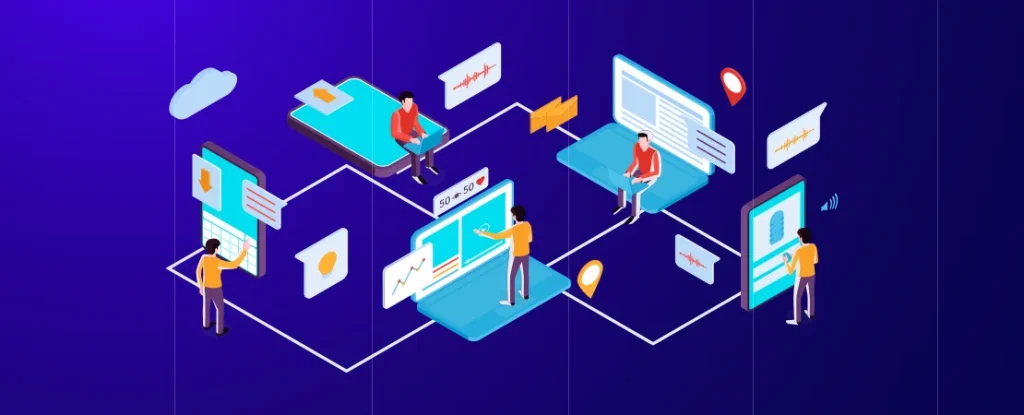Technology is useless unless it is easy to use and offers a satisfactory customer experience holistically. This is why businesses investing heavily in technology will have to invest equally in offering digital experience design. A powerful design which is tied strongly to your customer needs and expectations will ensure that the end user feels control, satisfaction, and happiness throughout their interaction with the product/service.
To nail experience design, you’ll have to start with user research — the best way to understand user needs, thinking, and expectations.
89.2% of companies conduct research before the design stage.
— State of User Research 2021 report by User Interviews,
In this guide, we will cover the A-Z of experience design and how it goes on to define your business success.

What is Digital Experience Design?
Experience design is a holistic approach that focuses on the overall quality of user experience across customer journeys and channels. Experience design primarily focuses on creating a powerful and positive overall experience that the users will stick to the customer’s conscience.
The domain primarily focuses on creating a seamless, positive, and consistent overall experience measured in the form of user satisfaction and engagement levels.
A good and meaningful experience design implies that the user interface is neat and clean, the user experience design is seamless across touchpoints, and the overall customer experience across channels is satisfactory.
Elements of Digital Experience Design
Experience design (XD) is a broad term that covers everything from a neat and clean user interface to the overall customer experience a user receives.
The essential elements of digital experience design include — user interface (UI), user experience design (UXD), and customer experience (CX).
Let us discuss each of these elements in detail:
1. User Interface (UI)
Defines the visual appeal of the interface
KPI: Cleanliness, attractiveness, and understandability User interface (UI) is the front-end interface that is visible to the users when they interact with a digital product or a service. In other words, UI is the interaction point between the user and your brand.
The user interface should be understandable and easy to interpret across touchpoints and channels.
A user interface should be so simple that a beginner in an emergency can understand it within 10 seconds.

–Ted Nelson, American pioneer of information technology, Gartner
2. User Experience Design (UXD)
Defines the quality of interaction when using a single device or a single channel
KPI: Promptness and effectiveness of the system to perform the intended task
User experience design defines the satisfaction of interaction that a user has with a brand when performing a particular action. User experience design focuses on usability, accessibility, friendliness, responsiveness, and intuitiveness of the system.
The user interface should be understandable and easy to interpret across touchpoints and channels.
There are 8 steps for implementing user experience design, which include:
- Stakeholder Interviews
- Conduct User Research
- Execute UX Audit
- Gather Requirements
- Build Information Architecture
- Work on Visual Design
- Build Prototype
- Implement Testing
3. Customer Experience (CX)
Defines the lifetime experience a user has with the product
KPI: loyal customers, long-term customer relationship, word-of-mouth marketing
The customer experience (UX) focuses on building a relationship-level experience, i.e., the quality of experience a user has with your brand over a lifetime.
You’ve got to start with the customer experience and work backwards to the technology.

–Steve Jobs
The experience covers everything from researching about the product/service to buying, using, getting updates, receiving newsletters and ongoing support.
Digital Experience Design Example
A customer wishes to watch Money Heist on Netflix. He first subscribes to Netflix for a month, searches for the series, and finally watches it. Will he continue the subscription for another month?
A good UI will ensure that Netflix has:
- Ideal information architecture — The content is nicely categorized and labeled
- Visual Design — The interface design looks minimalistic and attractive
- Usable Interface — All the desired UI controls are available and easily findable while streaming, such as play, pause, leap controls, subtitles, language options, etc.
A good UXD will ensure that the customer can:
- Find a suitable plan and can easily subscribe to the service without much effort
- Search for “Money Heist” immediately once he enters the name into the search bar
- Start watching the series as soon as he clicks/touches the play button
A good CX will ensure that the customer:
- Gets a personalized experience in the form of recommendations from Netflix
- Gets timely resolutions from the Netflix team whenever the customer raises a query
- Does not feel any friction in performing any action across the platform whether accessing it through the mobile, tablet, or a desktop
In all, experience design will ensure that every stage of the process, as mentioned above. offers a connected, seamless, and satisfactory experience on the whole. It is the overall end-to-end experience that a customer transits through across stages and channels.
Digital Experience Design: Concepts
Essential concepts that are a part of digital experience design include:
1. Human-Centered Design
The human-centered design focuses on human behavior and their mindset when interacting with a user interface design. It primarily considers humans by focusing on empathy when designing digital products and services.
To understand design is to understand human problems; that is both the beginning and the end of design.

Mario Maruffi Experience Design Consultant
What do users want, how they interact with digital products, what problems they face, and their expectations from an interface — help ideate and build a robust experience design.
2. Information Architecture (IA)
Information architecture is about labeling, structuring, and organizing content for a digital product or service so that it looks orderly and is navigable. The primary objective of IA is to make the product usable and its features findable and discoverable.
Findability precedes usability. In the alphabet and on the Web. You can’t use what you can’t find.

Peter Morville
President of Semantic Studios, An Information Architecture Firm
The four essential parts of information architecture include:
- Organization: Organize content under distinguishable categories to make it look neat and clean
- Labeling: Each of the buttons, options, and features should be labeled so that the user is clear on its purpose and intent
- Navigation: Make the entire navigation easy and intuitive, i.e., it becomes easy to hop from one page to another without losing track while completing an intended action
- Search:Make the content findable (locating known features) and discoverable (locating features yet unknown to the users)
3. Dark Patterns
Dark patterns in UX design are tricks that a brand uses to manipulate a user into performing an action they didn’t intend to in the first place. Businesses feel that it is an easy way to increase traffic to a website and increase conversions. However, dark patterns are the biggest reason for abandonments and bad CX.
A popular type of dark pattern that influences the experience design is — roach motel, i.e., subscription to a product or service is easy. However, when it comes to canceling the subscription — finding the cancel option is tricky.
An essential part of building a great experience design is to be wary of dark patterns. These dark patterns ruin the overall customer experience of any user.
4. Skeuomorphism
Designing for familiarity is the idea behind skeuomorphism. The UI design elements used across the digital space should be intuitively designed, i.e., the user should know in advance that clicking a particular button will trigger what action.
UX trends such as flat design and neumorphism should also be considered when designing the user interface of the digital product or service.
5. Ethnography
Ethnography allows a business to walk into their customer’s shoes and understand their behavior, mindset, attitude, aptitude, and emotions.
Ethnography is a user research methodology that helps uncover the human expectations from a digital product and service under development.
Listen to this audio to gain a better understanding of digital ethnography when designing digital products.
Digital Experience Design Framework
A digital experience design framework is imperative to offer a meaningful and effective digital experience across products and services.
Here’s a 4-point framework that we call 4E’s of digital experience design:
- Explore: Use user research methods to understand the customer needs and expectations from you
- Evaluate: Run usability testing for existing user experience touchpoints to validate the cohesiveness of the system on the whole
- Experiment: Ideate and implement new ideas that will help fill the existing customer experience gaps
- Engage: Keep innovating and improving the digital experience design based on observation, feedback, and monitoring results
Digital Experience Design: Your Multi-Touchpoint Digital Strategy
A business needs to serve its customers with relevant, useful, and connected experiences across touchpoints to ensure ongoing engagement.
Here’s an overview of the stages involved in devising a robust digital experience design strategy:
1. Identifying Customer Journeys
The first step is to identify the different customer journeys that your buyer personas maneuver through when interacting with the digital product/service.
Once you have identified customer journeys (for the most important ones), the next step is to map the customer journeys across touchpoints. Customer journey mapping will help visualize the steps that the customers take when performing an intended action.
The mapping will help identify the pleasures and disappointments of customers across touchpoints, which will, in turn, help mend the gaps and offer an orchestrated customer experience across touchpoints.
Customer journey mapping for eCommerce — Here’s what it means and how it helps manage experience design.
2. Document the Journeys
Use the “persona design” approach to document the customer journeys. Here you create profiles of different buyer personas that highlight the needs of identified user profiles.
The approach helps with digital ethnography, i.e., identify emotional trigger points, user behavior, and their expectations from a brand.
3. Identify Different Touchpoints and Channels
After identifying and documenting the customer journeys, the next step is to build a customer experience map. This map will help analyze customer behavior and interaction across touchpoints and channels.
Here’s how a customer experience map looks like:
4. Work on Offering Omnichannel Customer Experience
Omnichannel customer experience implies that the customer has access to various touchpoints spread across channels that are connected and in cadence with each other.
Even if a customer leaves a particular channel midway, they can resume from the same point in the journey (irrespective of whether they use the same channel or a different one).
The number of companies investing in the omni-channel experience has jumped from 20% to more than 80%.
Building an omnichannel customer experience across channels and touchpoints is possible when you offer a consistent and connected customer experience.
Different touchpoints that need to be taken into consideration for managing digital experience design include:
- Open Web Sources — Quora, Reddit, G2, etc.
- Social Media Channels — Facebook, Twitter, LinkedIn, Instagram, etc
- Customer Service or Relationship Management — online chat, support requests, email service, loyalty programs, and push notifications
- Video — explainer videos, brand introductory videos, interviews, and demo videos
5. Establish Command and Control
Command and control help distinguish the different touchpoints and channels from different focus groups.
For example, both marketing and sales manage Twitter. Both the parties will ensure that a consistent brand image is showcased and transparency is maintained when managing interactions over the official social media account.
Also, command and control ensure that consistency across the experience design is maintained when customers switch channels.
6. Keep Optimizing
Managing digital experience design is not a one-time activity. You will have to keep optimizing it to ensure a consistent customer experience.
A good strategy is to use data analytics, analyze customer journeys, and implement continuous testing and updates. You can also try your hand at A/B testing different user experience versions and check what works best for your audience, and stick to it.
Conclusion
Maintaining a connected and consistent customer experience throughout is essential for every online business. The hierarchy of nailing experience design starts with building a user interface and goes on to managing the user experience design across touchpoints and channels.
If everything falls in place, a customer feels satisfied and happy with the overall experience, i.e., they have zero complaints or pain points across the customer journey.
This write-up offers a comprehensive view into every aspect of the experience design and the process to ensure brand cadence across channels and touchpoints.
In all, if the overall journey of a customer with a brand is smooth and seamless, be certain of one thing — you have a well thought off experience design.


